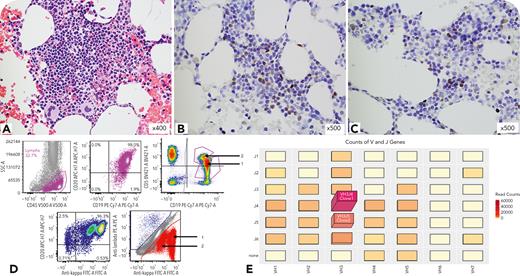A 64-year-old woman presented with fatigue and was found to have leukocytosis (white blood cell count of 15 × 109/L) and multicompartmental nonbulky lymphadenopathy. Bone marrow evaluation showed a hypercellular bone marrow with scattered lymphoid aggregates, composed of small mature lymphoid cells (panel A, hematoxylin and eosin stain), positive for PAX5, CD5, cyclin D1 (panel B), and SOX11 (panel C). Flow cytometric analysis detected 2 aberrant CD5+ B-cell populations with similar immunophenotype, except that the largest (14.3% of total events) (panel D) had bright κ expression and the smallest (2.8% of total events) (panel D) had dimmer κ expression. Fluorescence in situ hybridization studies were positive for IGH::CCND1/MYEOV rearrangement in 25% and MYC gene rearrangement in 25% of the cells. Complex karyotype was detected. Somatic hypermutation testing using a next-generation sequencing assay detected 2 dominant productive sequences: the largest (clone 1, panel E, heat map) was encoded by IGHV3-9-IGHJ4 and the smallest (clone 2, panel E) was encoded by IGHV3-15-IGHJ5. The deviation of IGHV sequences from germ line were 0% and 5.9% in the 2 populations, respectively. IGHV3-9-IGHJ4 sequences were more than twice in number as compared with IGH3-15-IGHJ5 sequences, indicating different clonal fractions.
ATM and DNMT3A gene mutations were detected. Biclonal mantle cell lymphoma (MCL) is rare and is hardly ever described. This case illustrates the significance of performing molecular testing in patients with MCL.
For additional images, visit the ASH Image Bank, a reference and teaching tool that is continually updated with new atlas and case study images. For more information, visit https://imagebank.hematology.org.


This feature is available to Subscribers Only
Sign In or Create an Account Close Modal